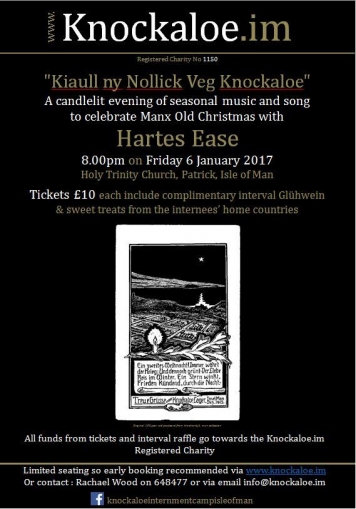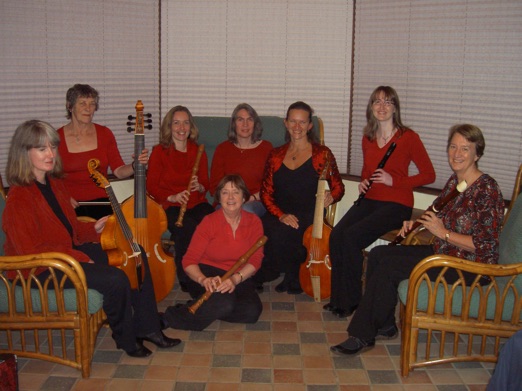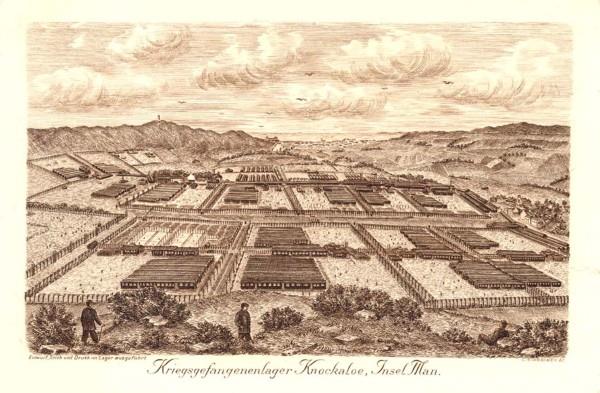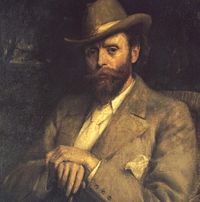Manx Christmas Concert that remembers those interned on the Isle of Man during the First World War
A very special event is taking place to celebrate the Old Manx Christmas at 8.00pm on Friday 6 January 2017 in the intimate candlelit setting of Patrick Church on the Isle of Man (Manx: Mannin). Old Manx Christmas Concert - Kiaull yn Nollick Veg Knockaloe will feature Hartes Ease, a local group specializing in 16th and 17th century Renaissance music. All funds from the £10 tickets and interval raffle will go towards the Isle of Man local charity www.Knockaloe.im which is developing a Visitors Centre for Knockaloe Internment Camp on the Isle of Man and a digital database of all its World War I internees. Patrick Church is situated adjacent to the old camp. Interval refreshments inspired by the internees' homelands, include a glass of warming Glühwein wine. The village of Patrick started a project some years ago to create Knockaloe Internment Camp & Patrick Visitor Centre in the old village of Patrick. It recognises the important part the camp played in Manx history and seeks to gain increased knowledge of the lives and experiences of those unfortunate internees imprisoned there.
Close to the village of Patrick, Knockaloe Internment Camp was constructed at the time of the First World War. This global conflict that originated in Europe lasted from 28 July 1914 to 11 November 1918. So called “enemy aliens” had their movements restricted during this time which saw the development of internment camps. Knockaloe Moar farm was identified as the location for such a camp. Originally designed for 5000 people, by the end of the War it held almost 24,000 internees. The internees were kept in 23 compounds each with four camps made up of wooden hut type buildings inside barbed wire, with the site covering some 22 acres.
The first of the civilian male internees arrived on 17 November 1914. The internees subsequently were of various nationalities including German, Austrian and Turkish. The camps closed in 1919, with a number of those held having served up to five years in the camp. Nearly 200 people died during their internment and were buried at Patrick Church which is close to the camp. Although this was a British operation and not one inspired by the Isle of Man authorities, Manx people have an increased interest in the lives and experiences of those who were interned on their island in those dark days.
Once the war was over and the camp dismantled, some of the huts were sold off to local people and the place quickly reverted back to farmland. It would appear that not many records of individual internees survived from the First World War. One of the few people who tried to preserve the experiences of German internees was the Manx writer Hall Caine (1853-1931), who published The Woman of Knockaloe in 1923. It tells the story of a young Manx woman who has a romance with a German prisoner of war. They face the fierce hostility of the local community which eventually drives them to commit suicide. The book was the basis for the 1927 American silent romance film Barbed Wire starring Pola Negri and Clive Brook. Following the films release the novel was republished under the title, Barbed Wire.
One of the musicians performing at the Old Manx Christmas Concert on 6th January is a member of the Mannin Branch of the Celtic League who was able to have it confirmed by the Knockaloe Project researcher that her great uncle was indeed one of the internees and so has been able to add a little more information to the history of Knockaloe Camp. The group was willing to put together a concert of the nationalities both internees and those involved with the day to day running of the camp a hundred years ago. All funds raised will go towards the Knockaloe Project. One of the images below is of the concert poster with an illustration from an original card made by internees of the camp in 1915. Other images are of Hartes Ease, Knockaloe Internment Camp as it was and a Portrait of Manx author Hall Caine. Details of the concert can be obtained from the Knockaloe.im website.




- Alastair Kneale's blog
- Log in to post comments






